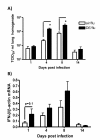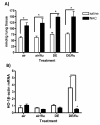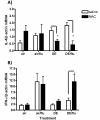Role of oxidative stress on diesel-enhanced influenza infection in mice
- PMID: 21092162
- PMCID: PMC3001415
- DOI: 10.1186/1743-8977-7-34
Role of oxidative stress on diesel-enhanced influenza infection in mice
Abstract
Numerous studies have shown that air pollutants, including diesel exhaust (DE), reduce host defenses, resulting in decreased resistance to respiratory infections. This study sought to determine if DE exposure could affect the severity of an ongoing influenza infection in mice, and examine if this could be modulated with antioxidants. BALB/c mice were treated by oropharyngeal aspiration with 50 plaque forming units of influenza A/HongKong/8/68 and immediately exposed to air or 0.5 mg/m3 DE (4 hrs/day, 14 days). Mice were necropsied on days 1, 4, 8 and 14 post-infection and lungs were assessed for virus titers, lung inflammation, immune cytokine expression and pulmonary responsiveness (PR) to inhaled methacholine. Exposure to DE during the course of infection caused an increase in viral titers at days 4 and 8 post-infection, which was associated with increased neutrophils and protein in the BAL, and an early increase in PR. Increased virus load was not caused by decreased interferon levels, since IFN-β levels were enhanced in these mice. Expression and production of IL-4 was significantly increased on day 1 and 4 p.i. while expression of the Th1 cytokines, IFN-γ and IL-12p40 was decreased. Treatment with the antioxidant N-acetylcysteine did not affect diesel-enhanced virus titers but blocked the DE-induced changes in cytokine profiles and lung inflammation. We conclude that exposure to DE during an influenza infection polarizes the local immune responses to an IL-4 dominated profile in association with increased viral disease, and some aspects of this effect can be reversed with antioxidants.
Figures







Similar articles
-
Modulation of pulmonary inflammatory responses and antimicrobial defenses in mice exposed to diesel exhaust.Toxicol Appl Pharmacol. 2008 Jun 15;229(3):310-9. doi: 10.1016/j.taap.2008.01.040. Epub 2008 Feb 15. Toxicol Appl Pharmacol. 2008. PMID: 18343473
-
Interleukin 12 administration enhances Th1 activity but delays recovery from influenza A virus infection in mice.Antiviral Res. 1998 May;38(2):117-30. doi: 10.1016/s0166-3542(98)00019-9. Antiviral Res. 1998. PMID: 9707374
-
Cellular basis of the role of diesel exhaust particles in inducing Th2-dominant response.J Immunol. 2005 Feb 15;174(4):2412-9. doi: 10.4049/jimmunol.174.4.2412. J Immunol. 2005. PMID: 15699178
-
Proinflammatory and Th1 cytokine alterations following ultraviolet radiation enhancement of disease due to influenza infection in mice.Toxicol Sci. 2002 May;67(1):88-97. doi: 10.1093/toxsci/67.1.88. Toxicol Sci. 2002. PMID: 11961220
-
Epithelial cells, the "switchboard" of respiratory immune defense responses: effects of air pollutants.Swiss Med Wkly. 2012 Jul 31;142:w13653. doi: 10.4414/smw.2012.13653. eCollection 2012. Swiss Med Wkly. 2012. PMID: 22851042 Free PMC article. Review.
Cited by
-
Acute diesel exhaust particle exposure increases viral titre and inflammation associated with existing influenza infection, but does not exacerbate deficits in lung function.Influenza Other Respir Viruses. 2013 Sep;7(5):701-9. doi: 10.1111/irv.12012. Epub 2012 Sep 21. Influenza Other Respir Viruses. 2013. PMID: 22994877 Free PMC article.
-
SARS-CoV-2 infection, COVID-19 pathogenesis, and exposure to air pollution: What is the connection?Ann N Y Acad Sci. 2021 Feb;1486(1):15-38. doi: 10.1111/nyas.14512. Epub 2020 Oct 6. Ann N Y Acad Sci. 2021. PMID: 33022781 Free PMC article. Review.
-
Exposure to combustion generated environmentally persistent free radicals enhances severity of influenza virus infection.Part Fibre Toxicol. 2014 Oct 30;11:57. doi: 10.1186/s12989-014-0057-1. Part Fibre Toxicol. 2014. PMID: 25358535 Free PMC article.
-
Nanoparticles modulate surfactant protein A and D mediated protection against influenza A infection in vitro.Philos Trans R Soc Lond B Biol Sci. 2015 Feb 5;370(1661):20140049. doi: 10.1098/rstb.2014.0049. Philos Trans R Soc Lond B Biol Sci. 2015. PMID: 25533100 Free PMC article.
-
Modulatory effects of low-dose hydrogen peroxide on the function of human plasmacytoid dendritic cells.Free Radic Biol Med. 2012 Feb 1;52(3):635-645. doi: 10.1016/j.freeradbiomed.2011.11.022. Epub 2011 Dec 8. Free Radic Biol Med. 2012. PMID: 22178414 Free PMC article.
References
-
- Pope CA, Burnett RT, Thurston GD, Thun MJ, Calle EE, Krewski D, Godleski JJ. Cardiovascular mortality and long-term exposure to particulate air pollution: epidemiological evidence of general pathophysiological pathways of disease. Circulation. 2004;109:71–77. doi: 10.1161/01.CIR.0000108927.80044.7F. - DOI - PubMed
-
- Pope CA, Dockery DW. Acute health effects of PM10 pollution on symptomatic and asymptomatic children. Am Rev Respir Dis. 1992;145:1123–1128. - PubMed
Publication types
MeSH terms
Substances
Grants and funding
LinkOut - more resources
Full Text Sources
Research Materials

